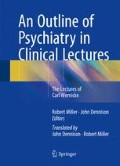Abstract
Before we approach clinical examination of mental patients, we shall try to get an overview of the tasks we face. Taken altogether, we call the subject of our study ‘mental disturbance’ [Ed]—a term quite familiar to lay people, and well suited to include all mental conditions deviating from the norm. Among such conditions it is useful first to select the simplest ones for study, i.e. those that we might hope to understand with no prior specialist knowledge, but just on the basis of general notions, such as were discussed in earlier lectures. The simplest are those with persisting alterations in the content of consciousness after recovery from mental illness. These in turn are divided into two major groups depending on whether they are qualitative—falsifications of consciousness, or quantitative—deficit states of consciousness. We encounter far more complex symptoms in ‘real’ [Ed] mental illnesses; the more so, the more acute and stormy their course. The contrast is between stable conditions and diseases actually in the process of developing; and to understand the former intrinsically presents fewer difficulties. This is just the same distinction as discussed earlier between the content of consciousness and conscious activity: Dealing with alterations to the content of consciousness in the course of normal or near-normal conscious activity is a simpler task. On the other hand, when actual mental illnesses unfold, we are spectators of conscious activity whose actual course is abnormal. Conscious activity shifts as a function of time, and its output is the specific content of consciousness; thus we can define acute mental illnesses as the process of altering the content of consciousness, which we see taking place in a defined time period. Such changes are often linked with Affects and changing moods, just as they are under conditions of healthy mental life. Acute mental illnesses are therefore almost universally accompanied by vivid Affects, and we note that these complicate understanding and treatment of acute mental illnesses. The shorter the duration of the acute mental illness, the more stormy the accompanying Affects tend to be; and in the event of the outcome not being an actual return to health, the greater are the resulting alterations in content of consciousness, be they qualitative or quantitative.
Access this chapter
Tax calculation will be finalised at checkout
Purchases are for personal use only
Author information
Authors and Affiliations
Editor information
Editors and Affiliations
Rights and permissions
Copyright information
© 2015 Springer International Publishing Switzerland
About this chapter
Cite this chapter
Miller, R., Dennison, J. (2015). Lecture 9. In: Miller, ONZM, B.A., B.Sc., PhD., R., Dennison, J.P., M.Sc., B.A., J. (eds) An Outline of Psychiatry in Clinical Lectures. Springer, Cham. https://doi.org/10.1007/978-3-319-18051-9_9
Download citation
DOI: https://doi.org/10.1007/978-3-319-18051-9_9
Publisher Name: Springer, Cham
Print ISBN: 978-3-319-18050-2
Online ISBN: 978-3-319-18051-9
eBook Packages: MedicineMedicine (R0)

